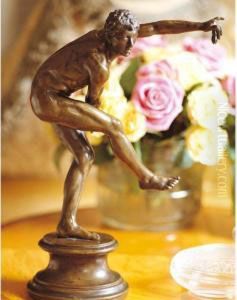James Havard Thomas Paintings
James Havard Thomas was a British sculptor born on March 7, 1854, in Cheltenham, England. He demonstrated an early interest in art and pursued his passion by enrolling at the South Kensington School of Art in London. He furthered his studies in Paris at the École des Beaux-Arts, where he was a pupil of the renowned French sculptor Jules Cavelier. Thomas' education in Paris was pivotal, as it exposed him to the academic traditions of French sculpture, which would influence his work throughout his career.
Thomas returned to England in the 1880s, where his work began to attract attention. He was known for his meticulous attention to detail and his ability to capture the subtleties of human form. Thomas' sculptures often reflected a classical sensibility, with a focus on the beauty of the human figure, which he rendered with a sense of both idealism and naturalism. His works were exhibited at the Royal Academy and other prestigious venues, earning him recognition and respect among his contemporaries.
Despite his success, Thomas was not without his struggles. He worked painstakingly slowly, which meant that his output was limited, and this affected his financial stability. Nevertheless, he remained committed to his artistic vision, producing sculptures that were celebrated for their delicacy and emotional depth. His notable works include 'Lycidas', a memorial to his friend, the poet Robert Calverley Trevelyan, and 'The Age of Innocence', which showcases his skill in capturing the innocence and tenderness of childhood.
James Havard Thomas' career was also marked by his role as an educator. He taught sculpture at the Slade School of Fine Art in London, where he influenced a new generation of British sculptors. His teaching was characterized by an emphasis on the importance of working from life, encouraging his students to develop a keen observation of the human figure.
Thomas' legacy is one of a dedicated and talented sculptor who strove to express the beauty of the natural world through his art. He continued to work and teach until his death on February 14, 1921. Today, his works are held in various collections and continue to be appreciated for their technical skill and artistic beauty.
